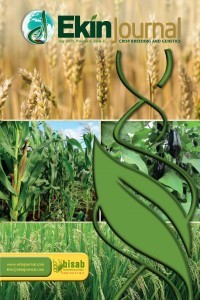Investigations on the Effect of Genes Controlling Response to Vernalization on Adaptation of Common Wheat (Triticum aestivum L.)
Investigations on the Effect of Genes Controlling Response to Vernalization on Adaptation of Common Wheat (Triticum aestivum L.)
Common wheat, Triticum aes tivum L., , vernalization, isolines, , grain yield, yield related traits.,
___
- Aamodt OS (1923). J. Agric Res (Washington, DC), 24: 457-469.
- Arya RK, Munjal R and Dhanda SS (2012). Evaluation of bread, durum and synthetic wheats and triticale for physiological traits under heat s tress conditions, National seminar on sus tainable agriculture and food security: challenges in changing climate, 27-28 March 2012, CCS HAU, Hisar, India.
- Attary AA and KA (1993). Study on adaptability of different wheat (T. aes tivum L.) genotypes in various climatic areas in Iran, Proceedings of the Eighth International Wheat Genetics Symp, China Agricultural Scientech Press, Beijing, 2:1081-1086.
- Baker RJ (1969). Genotype-environment interactions in yield of wheat, Can, J Plant Sci 49:743-751.
- CIMMYT (1997). CIMMYT Pedigree pocket handbook version Mexico, D, F, Mexico.
- Coms tock RE and Moll RH (1963). Genotype environment interactions, Statical Genetics and Plant Breeding, Nat, Acad, Sci, Nat, Res, Counc, Publ, No, 982, pp:164-196.
- Davoud AA, Mahfoozi S, Sharghi Y and Zahedi H (2015). Evaluation of vernalization requirement in wheat inbred lines and cultivars under controlled conditions, Int J Biosci 6:1-8.
- Flood RG and Halloran GM (1982). Annals of Botany, London (NS), 49: 469-475.
- Gill KS, Nanda GS and Singh G (1984). Stability analysis over seasons and locations of multilines of wheat (Triticum aes tivum L.) Euphytica, 33: 489-495.
- Gordon IL, Byth DE and Balaam LN (1973). Variance of heritability ratios es timated from phenotypic components, Biometrics, 28: 401-415.
- Ikiz F (1976). Statis tical analysis of genotype x environment interaction in wheat breeding, Ph, D thesis, E, Finish, Agriculture Fac. Agronomy- Genetics Chair, Izmir, 111p (unpublished).
- Limin AE and Fowler DB ( 2002). Developmental traits affecting low-temperature tolerance response in near-isogenic lines for the vernalization locus Vrn-A1 in wheat (Triticum aes tivum L. Em Thell), Annals of Botany 89: 579-585, 2002 Annals of Botany Company.
- Limin AE and Fowler DB (2006). Low-temperature tolerance and genetic potential in wheat (Triticum aes tivum L.) response to photoperiod, vernalization, and plant devolopment, Planta (2006) 224: 360-366, Department of Plant Sciences, University of Saskatchewan, Canada.
- Mead R (1988). The Design of Experiment, Statis tical Principles for Practical Applications, Cambridge University Press, Cambridge, 620p.
- Molina RB (1985). Genetic Analysis of Adaptation in Wheat: Influence of Genes Controlling Vernalization Response, Ph, D Thesis, University of California, 155p (unpublished).
- Mus tatea P, Ittu G and Saulescu NN (2011). Effect of vernalization requirements on heading date and grain yield of near-isogenic lines of wheat (Triticum aes tivum L.) Romanian Agricultural Research 28: 3-10 Oztan M (1992). Research on genotype x environmental interactions in wheat, PhD Thesis, Ege University Ins titute of Science, Field Crops Department, Izmir, 116p.
- Preeti, Singh PI, Rajesh KA and Divya P (2016). Effect of environment on yield accumulation in wheat cultivars under Haryana conditions, Int, J, Farm Sci, 6: 261-265.
- Pugsley AT (1983). Identification and management of major genes monitoring yield and adaptation, Proceedings of the 6th International Wheat Genetics Symposium, Kyoto, Japan, 971-974.
- Rasmusson DC and Lambert JW (1961). Variety x environment interactions in barley variety tes ts, Crop Sci, 1: 261-262.
- Sabancı CO (1991). Inves tigation of genotype x environmental interactions of important agronomic features in some common vetch varieties and lines, E, Finish, Sciences Ins titute, Department of Field Crops, Izmir, 125p (unpublished).
- Snedecor GW and Cochran WG (1960). Statis tical Methods, 7th Edition, The Iowa State University Press, Ames, Iowa, 507p.
- Steel RGD and Torrie JH (1960). Principles and Procedures of Statis tics, McGraw-Hill Book Co, Inc, New York, 481p.
- Tecator Manual (1979). Kjeltec Sys tem 1002 Dis tilling Unit, Hoganas Sweden, 17p.
- Uluoz M (1965). Wheat Flour and Bread Analysis Methods, Ege University Press, Izmir, 95p.
- Yasuda S and Shimoyama H (1965). Analysis of internal factors in influencing the heading of wheat varieties, Ber, Ohara Ins t, Landw, Biol, Okayama Univ, 13: 23-38.
- ISSN: 2149-1275
- Yayın Aralığı: Yılda 2 Sayı
- Başlangıç: 2015
- Yayıncı: Bitki Islahçıları Alt Birliği
İsmet BAŞER, İlker GİDER, Oğuz BİLGİN, Alpay BALKAN
Ahmet BALKAYA, Tolga ÖZGEN, İsmail ERPER, Şenay MURAT DOĞRU
Registration of “NKU Asiya” Bread Wheat (Triticum aestivum L.) Variety
İsmet BAŞER, Kayıhan KORKUT, Oğuz BİLGİN, Alpay BALKAN
Rajesh Kumar ARYA, Mehar Chand KAMBOJ, Suresh KUMAR
Registration of “Sezgin” Chickpea (Cicer arietinum L.) Variety
Dürdane MART, Meltem TÜRKERİ, Derya YÜCEL
Registration of “Akçalar” Hungarian Vetch (Vicia pannonica Crantz) Variety
Firs t Report of Yellow Dwarf Viruses (YDVs) in the Rice Fields in the Trakya Region of Turkey
Registration of “Sabribey” Barley (Hordeum vulgare L.) Variety
Registration of “Karaman 2016” Dry Bean (Phaseolus vulgaris L.) Variety
